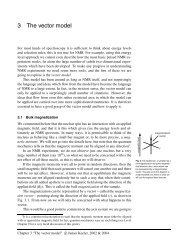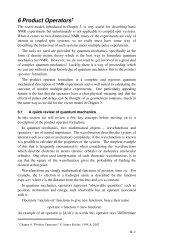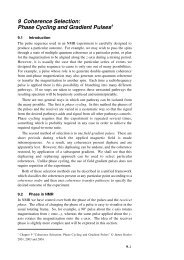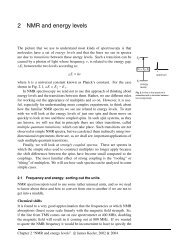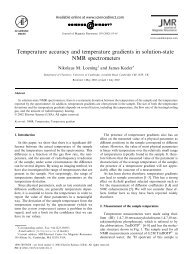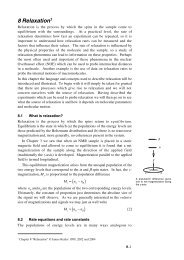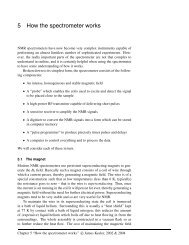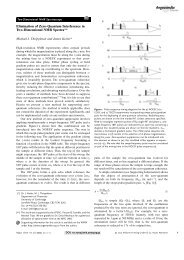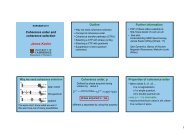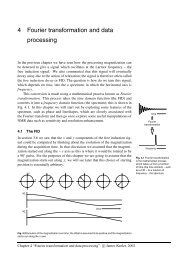Phase Cycling and Gradient Pulses - The James Keeler Group
Phase Cycling and Gradient Pulses - The James Keeler Group
Phase Cycling and Gradient Pulses - The James Keeler Group
You also want an ePaper? Increase the reach of your titles
YUMPU automatically turns print PDFs into web optimized ePapers that Google loves.
1<br />
0<br />
–1<br />
–y<br />
t 1 τ m<br />
t 2<br />
<strong>and</strong> I –<br />
1<br />
cosΩt ( I + I )<br />
9–14<br />
2 1<br />
+ −<br />
Of these operators, only I –<br />
leads to an observable signal, as this corresponds to<br />
p = –1. Allowing I –<br />
to evolve in t 2<br />
gives<br />
( ) −<br />
cosΩt exp iΩt I<br />
1<br />
2 1 2<br />
<strong>The</strong> final detected signal can be written as<br />
1<br />
S t , t cosΩt exp iΩt<br />
C<br />
( )= ( )<br />
1 2<br />
2 1 2<br />
This signal is said to be amplitude modulated in t 1<br />
; it is so called because the<br />
evolution during t 1<br />
gives rise, via the cosine term, to a modulation of the<br />
amplitude of the observed signal.<br />
<strong>The</strong> situation changes if we select a different pathway, as shown opposite.<br />
Here, only coherence order –1 is preserved during t 1<br />
. At the start of t 1<br />
the<br />
operator present is –I y<br />
which can be written<br />
( )<br />
1<br />
−<br />
2i<br />
I+ − I−<br />
Now, in accordance with the CTP, we select only the I –<br />
term. During t 1<br />
this<br />
evolves to give<br />
( ) −<br />
exp iΩt I<br />
1<br />
2i<br />
1<br />
Following through the rest of the pulse sequence as before gives the following<br />
observable signal<br />
( )= ( ) ( )<br />
1<br />
SP t1, t2<br />
exp iΩt exp iΩt<br />
4 1 2<br />
This signal is said to be phase modulated in t 1<br />
; it is so called because the<br />
evolution during t 1<br />
gives rise, via exponential term, to a modulation of the<br />
phase of the observed signal. If we had chosen to select p = +1 during t 1<br />
the<br />
signal would have been<br />
( )= ( ) ( )<br />
1<br />
SN t1, t2<br />
exp –iΩt exp iΩt<br />
4 1 2<br />
which is also phase modulated, except in the opposite sense. Note that in either<br />
case the phase modulated signal is one half of the size of the amplitude<br />
modulated signal, because only one of the two pathways has been selected.<br />
Although these results have been derived for the NOESY sequence, they are<br />
in fact general for any two-dimensional experiment. Summarising, we find<br />
• If a single coherence order is present during t 1<br />
the result is phase<br />
modulation in t 1<br />
. <strong>The</strong> phase modulation can be of the form exp(iΩt 1<br />
) or<br />
exp(–iΩt 1<br />
) depending on the sign of the coherence order present.<br />
• If both coherence orders ±p are selected during t 1<br />
, the result is amplitude<br />
modulation in t 1<br />
; selecting both orders in this way is called preserving<br />
symmetrical pathways.<br />
9.4.2 Frequency discrimination<br />
<strong>The</strong> amplitude modulated signal contains no information about the sign of Ω,



